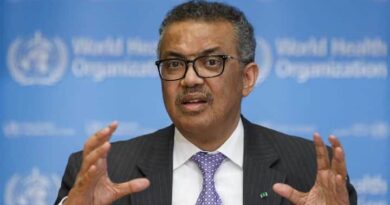The Person who Vaccinated two Epidemics in India
The Hafkin Jeevauddha Mahamanam Mandal of Mumbai came into abrupt discussion a few years ago when Shiv Sena started trying to construct the Bal Thackeray Memorial in its premises. Later, the site of this memorial changed, but this entire episode told how we have forgotten the contribution of the person who played a big role in getting India out of not one or two epidemics.
Born in Odessa, Ukraine, Waldemar Mordecai Hafkin’s arrival in India was merely a coincidence of his life. It is different that he spent the 22 most important years of his life here.
He received his doctorate from St. Pittsburgh but could not become a professor because a Jew could not get such a large position in the Russian Empire of the Tsar. After which he thought it right to say goodbye to his country and he reached Geneva. Here he got the job of teaching Physiology but he was not satisfied and reached Paris, with his mentor Louis Pasteur.
Although he received the post of assistant librarian at the Pasteur Institute, he continued his study of bacteriology, which soon turned to the making of the cholera vaccine. Hafkin first tested this vaccine on chicken and then injected himself with the vaccine. The vaccine he prepared had to have two injections given at a fixed interval.
On being satisfied, when he thought of using it extensively, all the experts disagreed with him. Even his mentor Louis Pasteur did not agree with him.
Heavy opposition in India
The claim of a vaccine had already been proved to be false and it was said that cholera is mainly an intestinal disease and the vaccine could not succeed.
Meanwhile, by chance Hafkin met Lord Frederick Hamilton Dufferin, who was the British Ambassador in Paris at the time and had also been the Viceroy of India before. Cholera had spread in India on a large scale.
Lord Frederick believed that this vaccine should be used in Bengal. His efforts soon brought Hafkin to India.
When he reached Kolkata in March 1893, many kinds of protests were waiting for him there. There was doubt about whether the vaccine could be successful, according to the Journal of Medical Biography, then it was also being said that the variety of bacteria that spread cholera in India is different from the one on which they have done experiments in Paris. Not going to be of any use.
It was also being said that the common people of India consider the epidemic to be a divine disaster and do not even take allopathic medicine for it. How would they be willing to have two painful injections for this?
In the midst of all these protests, Hafkin built his laboratory, but the biggest problem was that when he reached Bengal, the outbreak of cholera was over there. However, it was still raging in Awadh and Punjab province.

The world’s first large-scale vaccine test
The biggest problem was coming to the army and the army approached Hafkin. He first went to Agra and then he roamed in the cantonments of North India and injected about 10 thousand soldiers. The experiment was successful and there was a demand for Hafkin across the country.
When the outbreak of cholera returned to Kolkata, he was called there. He also went to the tea garden laborers of Assam and was also in jail. In no time, they gave vaccines to more than 42 thousand people. It is considered to be the world’s first large-scale vaccine test. Soon Hafman produced a new version of the vaccine, which required a single injection.
When India became free from the cholera epidemic, the bubonic plague knocked here. The plague’s havoc and fear was more than cholera as it killed more than half of the infected people. This time too, Hafkin was given the responsibility of preparing the vaccine and he was invited to Mumbai for this, where a laboratory was built for him at Grant Medical College.
Hafkin arrived there in October 1896 and within three months, he not only prepared the vaccine but also made its first successful test on a rabbit. This time too, he adopted the same method and did the first human test on himself. But the real test was done on the inmates of Byculla jail in the neighborhood. In those days, testing of prisoners on drugs was not new.
154 prisoners were prepared for this, they were first infected with the plague. Three prisoners died on the very first day of the vaccine. A few more prisoners also died in the next few weeks. But Kuljama considered this experiment successful and soon after this, a thousand people were injected with this vaccine in the areas of infection.
Even in the medical world of the world, this vaccine was considered largely successful. However, later in the long-term assessment, it said that it was successful only in 50 percent of cases. But saving the lives of 50 percent of people during an epidemic would also be considered an achievement.

Hafkin continued to experiment on this vaccine throughout the country for the next few years. But during this time, an incident occurred in Mulkowal, a village in Punjab, which is called Mulkowal disaster in the history of medicine.
On October 30, 1902, 107 people were given this vaccine in this village. After a few days, symptoms of tetanus were found in 19 of them and soon they all died. The charge came on Hafkin and he was dismissed. This news spread so much that it even arose in Britain’s House of Commons.
Desperate Hafkin returned to Paris and from there continued to defend himself with letters. After further investigation, it was found that it was not their fault. One of his assistants had put a dirty lid on the vaccine bottle causing this problem.
After this Hafkin returned to India, this time he was made the director of the Biological Laboratory of Kolkata. There was no system of vaccine research and production in this laboratory. Perhaps Mulkowal’s accusations did not leave him.

Hafkin can become an inspiration
It is said that during this period, he was influenced by the non-violence of Jainism and he completely stopped the use of animal birds.
In his memoir, noted bacteriologist William Baloch has written that in his last phase in Kolkata, Hafkin became furious about such things.
It is said that once he had scolded one of his colleagues very much just because he was doing a tapeworm examination.
In the midst of these circumstances, in 1915, when he turned 55, he was retired and he returned to Europe. Three years later, India remembered her once when the Spanish flu epidemic spread. But Hafkin was not available this time. Away from science, he was now trying to live his life according to Jewish religious beliefs. With which he also wrote an article – ‘Plea for Orthodoxy’ – that is, the logic of bigotry.
Some people also called him ‘Mahatma Hafkin’ for his successes. A book was also published on him with the same title. In 1925, his laboratory at Grant Hospital was renamed the Hafkin Institute. In 1964, the Indian Postal Department also issued a stamp on him.
At this time, when scientists from all over the world are trying to find the vaccine of Kovid-19, Hafkin can be an inspiration for them.




